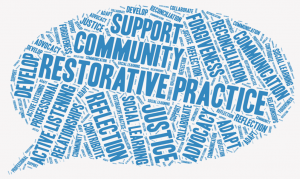In recent years, we’ve seen an alarmingly sharp rise in mental health challenges among children. Anxiety, depression, feelings of isolation, and a lack of sense of belonging are becoming commonplace for many children and teenagers. Mental Health Services can’t cope. So much so that, in 2022-23, there were over 340,000 children on the waiting list for MH services{1}. Worryingly, acute ward admissions rose by 65% between 2012 and 2022{2}. Surely, early intervention/prevention would be the preferred alternative, rather than waiting until a child is in crisis, which is what is currently happening! One powerful, yet simple and often overlooked, preventative tool, stands out: the Restorative Approach.
The Restorative Approach as a Whole School Ethos
The Restorative Approach is often seen simply as a way to manage conflict or misbehaviour in schools but is in fact far more than that. When truly embraced, it becomes a way of being in a school, where the whole school ethos is centred around relationships, reparation and responsibility. This builds connection, community, and provides children with the protective factors they so desperately need. Schools are in a unique and powerful position to help children develop the resilience necessary to survive, and thrive, during times of adversity.
A true Restorative Approach is not a tool to pick up when things go wrong. It is part of the everyday interactions within a school. It’s how staff talk and listen to students, how students talk to each other, and how the whole school community responds when harm occurs. This doesn’t mean there are no boundaries or consequences. But it does mean those consequences are rooted in learning and relationships, not blame, shame or punishment.
As a result, a restorative school culture fosters a sense of belonging, one of the strongest buffers against mental ill-health{3}. It teaches that mistakes are opportunities to learn, that conflict can lead to growth, and that relationships matter. These protective factors build a foundation of resilience, helping children navigate not just school, but life itself.
From Punishment to Restoration
Traditional punitive approaches to discipline tend to focus on blame and punishment: who did wrong and how they should be sanctioned. While this may bring short-term compliance, it rarely creates meaningful and lasting change. Punishment often pushes children away, damages relationships, and fuels feelings of shame or rejection; precisely the factors that increase vulnerability to mental ill-health. Exclusion, detentions, and suspensions may stop immediate misbehaviour, but they do little to teach the skills needed to repair harm or navigate relationships, nor do they help children to see the impact of their actions on others, take responsibili ty for their actions or develop empathy. In fact, they do the opposite; they push away and alienate those children who particularly need to belong.
ty for their actions or develop empathy. In fact, they do the opposite; they push away and alienate those children who particularly need to belong.
Restorative conversations encourage young people to explore how their actions affect others, and to be heard themselves. This fosters emotional literacy and empathy – skills proven to protect against poor mental health (in fact, EQ – Emotional Quotient – is a better predictor of success in later life than IQ – Intelligence Quotient{4}). Furthermore, when children feel heard, valued, and connected to their community, their resilience grows. Instead of being excluded or shamed, they learn to reflect, repair, and restore.
Back to the Roots of ‘Discipline’
After all, the word discipline originally comes from the Latin disciplina, meaning “to teach or instruct” and “to learn”. Discipline was intended to guide and educate, not punish. Over time, however, the term has become almost synonymous with punishment – a shift that has contributed to systems where children are punished rather than guided. RA restores discipline to its original meaning. Instead of asking, “Who is to blame?” it asks, “What happened, who was affected, and what can we do to make things right?” Instead of punishment, RA emphasises learning, reflection, and relationship-building. Restorative conversations give both the harmer and the harmee the opportunity to be heard in a non-judgemental, supportive and safe space. This not only builds and repairs relationships, but helps everyone feel valued, respected and that they belong; these are the very protective factors that research shows help young people thrive.
A Case in Point
Imagine a student hits another student. In a punitive system, the likely response would be detention or exclusion. In other words, imposing a consequence but doing little to explore the reasons behind the behaviour or its impact on the other student. The harmer is given no opportunity to explain what drove their actions or to hear how those actions affected the other student. The harmee is left without a voice; unable to share how the incident made them feel or to receive reassurance that it will not happen again. Neither child’s needs are met, and no steps are taken to repair the harm, rebuild trust and move forward. In essence, the harm remains unresolved.
In contrast, a restorative approach brings the harmer and the harmee together, focusing on dialogue, accountability, and repair. In that safe, non-judgemental space, the harmer is able to reflect on their behaviour, express what they were thinking and feeling at the time, and listen to the perspective of the person they harmed. The harmee has the opportunity to speak openly about the impact, be heard, and receive acknowledgment of their feelings. Together they can work toward understanding and agree steps to make amends, creating the possibility of healing and preventing future harm.
Punitive methods focus on compliance rather than connection. They may stop undesired behaviour temporarily, but they fail to teach the deeper skills of emotional literacy, empathy, or self-regulation. Restorative Approaches address the root causes of misbehaviour, strengthen relationships, give children a sense of belonging and create protective factors that improve mental health and well-being.
What’s Next?
If you are an educator, parent, or policymaker, consider how your school culture responds to behaviour. Ask yourself: does it push children away, or bring them back into the fold? By embedding restorative practices, we can protect mental health, restore the true meaning of discipline, and create stronger, more resilient school communities and children better equipped to face the world.

Behaviour Matters has been helping schools implement Restorative Approaches, including training children as Peer Mediators, for over 12 years. If you’d like to learn more about how it might benefit your school, I’d love to chat. Please give me a call on 07432033569 or dop me an email at leanneguillen@behaviourmatters.org.uk
{1} Children’s Commissioner for England on Children’s Mental Health Services, 2024
{2} The Lancet Child and Adolescent Mental Health, 2025
{3} Allen, KA., Greenwood, C.J., Berger, E. et al. Adolescent School Belonging and Mental Health Outcomes in Young Adulthood: Findings from a Multi-wave Prospective Cohort Study. School Mental Health 16, 149–160 (2024)
{4} EQ vs. IQ Which is Most Important in the Success of Failure of a Student? Procedia – Social and Behavioural Sciences, 46, 5211-5213 (2012)



